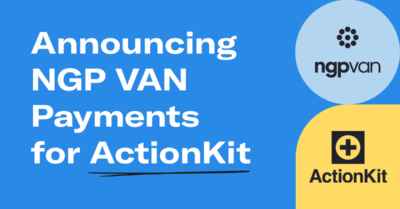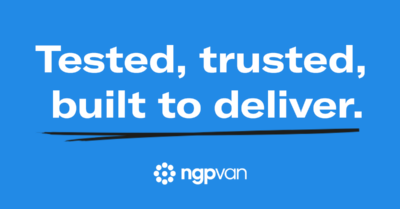Political Fundraising Emails: A Guide to Better Fundraising

It’s no secret that political fundraising emails are a vital source of revenue for many modern political campaigns. In fact, you’ve probably received many political fundraising emails yourself. If you want to understand how to write fundraising emails for your political campaign or cause, you’ve come to the right place! In this blog, we’ll explain some of the key factors to consider when writing and sending your emails, share some political fundraising email examples, and more. Let’s go!
What Exactly is a Political Fundraising Email?
Political fundraising emails are electronic messages sent on behalf of a political campaign or cause to raise money. While they may take different forms and include different elements (like pictures, graphics, etc.), their ultimate goal is to drive supporters to make a contribution. These emails serve as a direct line of communication between campaigns or organizations and their supporters. Unlike other forms of political fundraising (like events or call time), email fundraising is a cost-effective and scalable way to reach a wide audience of supporters at the click of a button. However, while you can reach supporters quickly, you have to make your fundraising emails don’t trigger a spam trap that could harm your deliverability metrics and write an eye-catching subject line so they stick out within their crowded inbox. Those are just two things to consider, but what other factors should you consider when writing your fundraising emails?
How to Write a Great Political Fundraising Email
There are a number of factors that you need to consider when writing your political fundraising emails including who you’re writing to, who you’re sending them to, how you’re making them relevant to those recipients, and how you’re getting them to open and engage with your emails.
Understand Your Audience
Understanding your audience is critical when writing your emails. Think about how you’d speak to someone if you’re meeting them for the first time versus how you’d greet your best friend. You’d talk to them differently, and you should take the same approach when writing your emails. Any data that you can use to inform your writing should be considered and used tactfully to help craft a better message. For instance, did your supporters subscribe to your newsletter through a petition about a specific issue? Or give through a specific donation form about something in particular? That data can be helpful in framing your email to those specific donors to make it more relevant and hopefully increase the chances of them making a donation. However, you also need to develop a list of email addresses that you can send to in order to raise money for your campaign or cause.
Build A High-Quality Email List
As we mentioned previously, the quality of your email list is also important when you’re trying to use it to raise money. If you found and added random email addresses to it, bought or rented a list to expand it, or compiled a low-quality list, you’re unlikely to see significant returns from those email addresses. It’s best to completely avoid ever purchasing a list. No one likes spam, and many email software providers, including us, regularly monitor and review spam complaints and reports to help curb those who abuse the system. Plus, triggering a spam trap can be detrimental to your email program, setting you back by weeks or even months of development and costing you valuable fundraising dollars and supporter engagement. Building and maintaining a high-quality email list is vital to your political fundraising efforts because it increases the likelihood of supporters taking action for your campaign when they receive your emails rather than going into their spam folders.
Segmentation & Personalization
Segmenting your email list based on certain criteria can allow you to tailor your email marketing to more effectively speak to specific audiences. For instance, by choosing to segment your list by location, you could say something like, “We need 50 more donors from Scranton to make a contribution by midnight tonight.” You could also think of segmenting the audience by engagement level or past contribution history. Each of these segmentations offers a unique frame to consider for your fundraising emails.
In addition to segmenting your email list, you can also personalize your emails to speak directly to your supporters. By using merge fields that can include things like a supporter’s name, previous contribution, or location, you can create more relevant and authentic emails that may encourage donors to give to your campaign compared to generic emails. That’s why it’s typically best to include merge fields in your political fundraising email templates so you can automatically include more personalization in your emails regardless of the type of content in the rest of the email.
Formatting Your Fundraising Emails
You could write the best fundraising email ever and have the perfect list of supporters to send it to, but a dull subject line could decrease your open rates and generate less action for your campaign. That’s why it’s so important to think about ways you can write subject lines to stand out among the rest of the emails in supporters’ inboxes. Think about personalizing the subject line with a supporter’s name, sharing an upcoming deadline, or something else that may encourage them to open the email. Once it’s opened, you need to keep supporters engaged with compelling content that keeps them invested in your email to read it through to the end. Throughout the email, you’ll want to include a few options for people to click and donate to your campaign. And at the end of the email, you’ll want to include a clear call to action (perhaps with personalized or suggested donation amounts) to encourage people to give to your campaign.
Political Fundraising Email Examples
More than likely, you’ve got some examples of political fundraising emails sitting in your inbox right now! Feel free to review them and see what you do and don’t like about them, and work to develop political fundraising email templates that work for your campaign. Add your campaign logo, greetings, merge fields, and any legally required disclaimers. These templates will serve as a starting point for your future fundraising emails and ensure consistency across your emails so they’re instantly recognized by your supporters.
If you’re looking for some ideas about what you can write about, check out these political fundraising email prompts! Test different types of emails, subject lines and see what resonates best with your supporters then seek to create more of that content while continuing to test and optimize.
- The Personal Appeal: This email shares a personal story that connects with supporters. The subject can be anything from sharing why you stepped up to run for office or joined your cause to stories from the campaign trail. These emails emphasize the importance of supporters chipping in to make the change they want to see a reality. These personal and authentic emails strike a very different tone compared to many traditional political fundraising email examples (like those that center around urgency or donation matches), and they may also stand out amongst supporters’ crowded inboxes.
- The Urgent Call to Action: While most fundraising emails probably have a sense of urgency attached to them, some emails will center around an urgent need or upcoming deadline. These types of emails are usually sent to existing subscribers around the end of reporting periods or the end of the month. They typically feature language like, “We need to raise $100,000 by 12/31 at 11:59 p.m. to hit our goal” and contain multiple places where supporters can click to donate, including one clear call to action at the end of the email.
- The Milestone Celebration: Every win, big and small, for your campaign or cause can serve as an important milestone to share with your supporters. Share some of your recent or upcoming milestones that can serve to show your momentum. Qualifying to get on the ballot or for a debate, hitting fundraising or canvassing goals, and more can all be used as subjects for your emails. Thank your supporters for all their contributions so far, and encourage them to give again to keep your campaign moving forward.
- The Match: Some donors may be motivated by knowing that their contribution will be “matched” by another donor. While you need to do some work ahead of time to secure a matching donor (or donors), it can be an effective way for supporters to feel like their contributions are making an even greater impact on your campaign. Some donors will set their own limit (like $1,000 or a period of time) or allow you to go to the maximum contribution limit (if applicable). To be clear, your matching donors and other supporters are contributing from their own personal funds, but the matching donor(s) will just contribute the total funds raised up to their set threshold. So, if your matching donor says they’ll match up to $1,000, and you raise a $1,000 from 20 supporters, that matching donor will give you $1,000, for a total of $2,000 raised for your campaign.
- Behind the Scenes: Lastly, some supporters may not know all of what goes into running a campaign – like the long hours spent in call time, talking to voters, and making important decisions about your campaign plan. Sometimes, it’s worth sharing some pictures from behind the scenes so they can understand how dedicated you are to winning this race and hopefully match your efforts with their financial support.
It’s typically best to vary your email content to keep your subscribers engaged with different formats, stories, and more. In addition to the political fundraising email examples we shared here, feel free to get creative with your emails. Some of the best-performing emails share empowering stories, inspiring testimonies, and other content that may stick out from the typical fundraising emails we see regularly. In our webinar with Do Big Things, we dive deeper into telling a story through your content that may help you understand how you can write your emails to encourage supporters to take action and stand out in their inboxes.
Now that you have some ideas on what to write about, it’s time to get to the main point of your emails: the ask.
How Much to Ask for in Political Fundraising Email
Determining how much to ask for in your fundraising appeals can be a difficult task. But, there are a few things you can consider to help make a well-informed ask rather than a random one. If they’re a prospective donor, conduct donor research to try and gauge how much they may be able to give to your campaign. Or consider asking for a small donation to gather more information about the donor to act on in the future. If they’re an existing donor, ask for their highest previous contribution amount or more if you think they can give more (assuming they haven’t already maxed out to your campaign). Also, consider how much money you’re planning to raise from your political fundraising emails to determine what you should ask supporters for. If you want to raise $100,000 via email, but you have a list of 1,000 subscribers and you ask for $5, you’ll probably have a tough time achieving that goal. But, if you personalize your asks, you may have a better chance of hitting that goal.
While it’s not easy to personalize emails with different ask amounts without advanced email and fundraising software, you should still try to change your ask amount depending on who you’re speaking to. For instance, if you ask everyone on your list to donate $100, that’s likely too much for some and not enough for others. Generalized asks can leave money on the table, and that’s why it’s important to develop personalized asks for donors. With NGP, you can easily ask for a donor’s highest previous contribution amount, most recent donation, average donation, or several other preset options. Plus, with Donor Target Scores and Reports, you can also help segment out groups of donors for email outreach, call time, and other fundraising appeals based on the likelihood of giving and their giving potential.
How Fundraising Emails Can Benefit Your Political Campaign
In addition to the obvious benefit of raising money for your political campaign, fundraising emails can benefit your campaign in other ways too. It’s easily one of the most cost-effective ways to raise money and connect directly with supporters. Fundraising emails allow you to test different subject lines, formats, and more that you can use to optimize your future emails to reach and engage your supporters. You can also view metrics that allow you to monitor email performance and report on progress in real time. Email fundraising is one revenue stream that feeds into your finance plan (the plan that describes how much you’ll spend and raise for specific purposes). While it may not offer the personal one-on-one time with your candidate like call time, it’s an easy way to quickly reach supporters and help raise the funding you need to run a competitive campaign.
Raise More Money for Your Campaign
By understanding your audience, building a high-quality email list, leveraging segmentation and personalization, and writing compelling emails, you can craft messages that resonate with donors and inspire them to support your campaign. By standardizing a few political fundraising email templates to use for your campaign, you can have a consistent and streamlined format to start building your email and ensure consistency across your emails. Remember to carefully consider the amount you ask for, tailoring it to the unique characteristics of your audience and fundraising goals. With the right planning and execution, sending political fundraising emails can be an efficient and effective way to raise money for your campaign and foster stronger connections with your supporters, setting your campaign up for success on Election Day and beyond.



